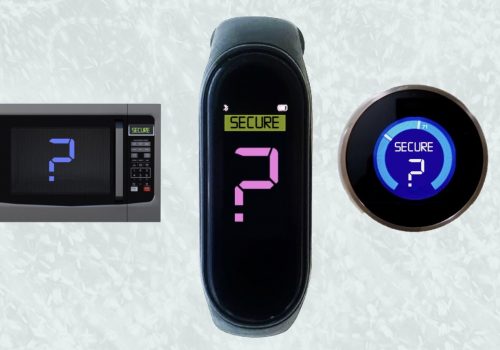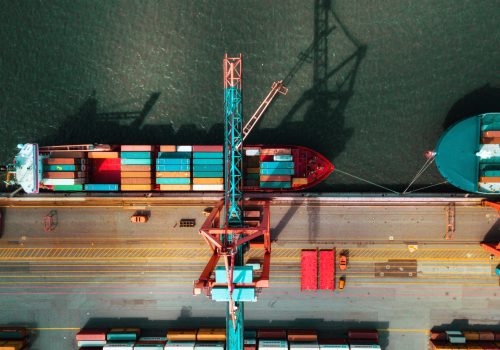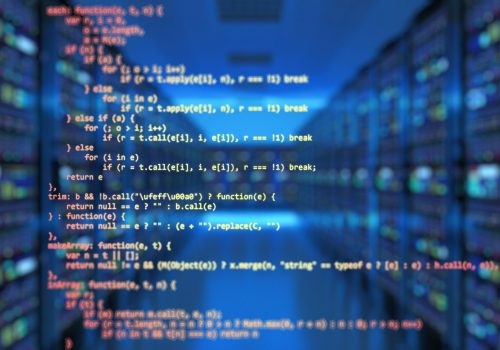The 5×5—The Internet of Things and national security

The connection of mundane household gadgets, industrial machinery, lifesaving healthcare technologies, vehicles, and more to the Internet has probably helped modern society to be more convenient and efficient. IoT devices worldwide number over 13 billion, a number that is estimated to balloon to over 29 billion by 2030. For all its benefits, the resultant web of connected devices, collectively known as the Internet of Things (IoT), has exposed everyday users, as well as entire economic sectors, to cybersecurity threats. For example, criminal groups have exploited IoT product insecurities to infect hundreds of thousands of devices around the world with malware in order to enlist them in distributed denial-of-service attacks against targets.
Inadequate cybersecurity across the IoT ecosystem is inherently a US national security issue due to IoT’s ubiquity, integration across all areas of life, and potential to put an incredible number of individuals’ data and physical safety at risk. We brought together five experts from various backgrounds to assess the national security challenges posed by IoT and discuss potential solutions.
#1 What isn’t the Internet of Things (IoT)?
Irina Brass, associate professor in regulation, innovation, and public policy, Department of Science, Technology, Engineering, and Public Policy (STEaPP), University College London:
“IoT is not just our everyday physical devices embedded with sensing (data capture) or actuation capabilities, like a smart lightbulb or a thermostat. ‘Smart’ devices are just the endpoint of a much more complex ‘infrastructure of interconnected entities, people, systems and information resources together with services, which processes and reacts to information from the physical world and virtual world’ (ISO/IEC 20924: 2021). This consensus-based definition, agreed in an international standard, is particularly telling of the highly dynamic and pervasive nature of IoT ecosystems which capture, transfer, analyze data, and take actions on our behalf. While IoT ecosystems are functional, poor device security specifications and practices in these highly dynamic environments create infrastructures that are not always secure, transparent, or trustworthy.”
Katerina Megas, program manager, Cybersecurity for the Internet of Things (IoT) Program, National Institute of Standards and Technology (NIST):
“Likely very little, which would explain why the US National Cyber Director, Chris Inglis, at a NIST public workshop [on August 17, 2022] referred to the ‘Internet of Everything.’ IoT is the product of the worlds of information technology (IT) and operational technology (OT) converging. The IoT is a system of interconnected components including devices that sense, actuate, collect/analyze/process data, and are connected to the Internet either directly or through some intermediary system. While a shrinking number of systems still fall outside of this definition, what we used to think of as traditional OT systems based on PLC architectures with no connectivity to the Internet are, in fact, more and more connected to the Internet and meet the above definition of IoT systems.”
Bruce Schneier, fellow, Berkman-Klein Center for Internet and Society, Harvard University; adjunct lecturer in public policy, Harvard Kennedy School:
“Ha! A salami sandwich is not the Internet of Things. A sense of comradeship towards your friends is not the Internet of Things. I am not the Internet of Things. Neither are you. The Internet of Things is the connected totality of computers that are not generally interacted with using traditional keyboards and screens. They’re ‘things’ first and computers second: cars, refrigerators, drones, thermostats, pacemakers.”
Justin Sherman, nonresident fellow, Cyber Statecraft Initiative, Digital Forensic Research Lab (DFRLab):
“There is no single definition of IoT, and how to scope IoT is a key policy and technical question. Regardless, basically every definition of IoT rightfully excludes the core underpinnings of the global Internet itself—internet service provider (ISP) networks that bring online connectivity to people’s homes and offices, submarine cables that haul internet traffic between continents, and so on.”
Sarah Zatko, chief scientist, Cyber ITL:
“IoT is not modern or state of the art. The hardware on the outside may look sleek and shiny, but under the hood there is old software built with out-of-date compilers running on old chip architectures. MIPS, a reduced instruction set computer (RISC) architecture, was used in the largest portion of the IoT products that we have tested.”
#2 Why should national security policymakers care about the cybersecurity of IoT products?
Brass: “Many IoT devices currently on the market have known security vulnerabilities, such as default passwords and unclear software update policies. Users are typically unaware of these vulnerabilities, purchase IoT devices, set and forget them. These practices do not occur just at the consumer level, although there are many examples of how insecure and unsafe our ‘smart homes’ have become. They take place in critical sectors of strategic national importance such as our healthcare system. For instance, the Internet of Medical Things (IoMT) is known to be especially vulnerable to cyberattacks, data leaks, and ransomware because a lot of IoMT devices, such as IV pumps, have known security vulnerabilities but continue to be purchased and remain in constant use for a long time, with limited user awareness of their potential exposure to serious compromise.”
Megas: “I think the combination of the nature and ubiquity of IoT technology are the perfect storm. IoT has taken existing concerns and put them on steroids by increasing both the attack surface and also impacts, if you think of risk as the product of likelihood (IoT is everywhere) and impact (automated interactions with the physical world). In traditional IT systems, a compromised system could produce faulty data to the end user, however, typically there was always a human in the loop that would take (or prevent) action on the physical world based on this data. With the actuating capabilities we are seeing in most IoT and the associated level of automation (which will only increase as IoT systems incorporate AI), the impact of a compromised IoT system is likely going to be higher. As more computing devices are put on the Internet, they become available for botnets to be installed, which can result in significant national economic damage as in the case of Mirai. Lastly, because this technology is so ubiquitous, the vast amount of data collected—from proprietary information from a factory to video footage from a recreational drone to sound sensors collected from around a smart city—can both be accessed through a breach, shared, and used by other nations without anyone’s knowledge, even without a cybersecurity failure.”
Schneier: “Because the security of the IoT affects the security of the nation. It’s all one big network, and everything is connected.”
Sherman: “IoT products are used in a number of critical sectors, ranging from healthcare to energy, and hacks of those products could be financially costly and disrupt those sectors’ operations. There are even IoT devices that can produce physical effects, like small internet-linked machines hooked into manufacturing lines, and hackers could exploit vulnerabilities in those devices to cause real-world damage. In general, securing IoT products is also part of securing the overall internet ecosystem: IoT devices plug into many other internet systems and increasingly constitute a greater percentage of all internet devices used in the world.”
Zatko: “IoT is ubiquitous. Even when a ‘smart’ device is not necessary, at this point it is often difficult or impossible to find a ‘dumb’ one. Their presence often punches holes in network environment security, so they are common access points for attacks.”
#3 What kinds of threats are there to the cybersecurity of IoT devices that differ from information technology (IT) or other forms of operational technology (OT)?
Brass: “The kinds of vulnerabilities per se might not differ—ultimately, you still have devices running software that can be exploited by malicious actors. What differs is the scale and, in some cases, the severity of the outcome. IoT ecosystems are highly interconnected. Compromising a single device is often sufficient to gain the foothold necessary to exploit other devices in the system and even the entire system. The transnational dimension of IoT cybersecurity should also not be neglected. The 2016 Mirai attack showed how compromised IoT devices with poor security specifications (default passwords), located around the world, can be very easily exploited to target internet infrastructure in different jurisdictions.”
Megas: “I am not sure whether there are different threats for IoT, OT, and IT systems. They are converging more and more, so it is not meaningful to try to create artificial lines of distinction. This might be one of those instances where I say the dreaded phrase ‘it depends.’ It is possible that there are some loosely coupled IoT systems in which the components that are IoT devices do not sit behind more security capable components, but are more directly accessing the Internet (and therefore more directly accessible by threat actors). This could mean that vulnerabilities in these IoT systems are more easily exploitable and thus easier targets. Also, the nature of IoT systems that can interact with the physical world could affect the motivations of threat actors. The focus on many risks to traditional IT systems is around the data and its potential theft, but attacks on IoT can impact the real world. For instance, modifying the sensors at a water treatment plant can throw off readings and lead the system to incorrectly adjust how much fluoride is added to the water.”
Schneier: “The IoT is where security meets safety. Insecure spreadsheets can compromise your data. Insecure IoT devices can compromise your life.”
Sherman: “Typically, IoT devices use less energy, have less memory, and have much less computing power than traditional IT devices such as laptops, or even smartphones. This can make it more difficult to integrate traditional IT cybersecurity features and processes into IoT devices. To boot, manufactures often produce IoT devices and products with terrible security—installing default, universal passwords and other bad features on the manufacturing line that end up undermining their cybersecurity once deployed. In part, this happens because smaller manufacturers are essentially pumping IoT devices off the manufacturing line.”
Zatko: “Users often forget to consider IoT devices when they think about their computing environment’s safety, but even if they did, IoT devices are not always able to be patched. Sometimes software bugs in IoT operating systems are hard-coded or otherwise inaccessible, as opposed to purely software products, where changes are much easier to affect. This makes getting the software as safe as possible from the get go particularly important.”
More from the Cyber Statecraft Initiative:
#4 What is the greatest challenge to improving the security of the IoT ecosystem?
Brass: “These days, we very often focus on behavioral change—what can individual users or organizations do to improve their cyber hygiene and general cybersecurity practices? While this is an important step in securing the IoT, it is not sufficient because it places the burden on a large, non-homogenous, distributed set of users. Let us turn the problem around to its origin. Then, the greatest challenge becomes how to ensure that IoT devices and systems produced and sold all over the world have baseline security specifications, that manufacturers have responsible lifecycle care for their products, and that distributors and retailers do not compromise on device security in favor of lower priced items. This is not an easy challenge, but it is not impossible either.”
Megas: “There is a role for everyone in the IoT ecosystem. Setting aside the few organizations developing their own IoT systems for their own use, the majority of IoT technologies are purchased or acquired. One of the challenges that I see is educating everyone that there are two critical roles in supporting cybersecurity of the IoT ecosystem: those of the producers of the IoT products and those of the customers, both enterprise and consumers. While this dynamic is not new between producer and buyers, the relationships in IoT lack maturity. While producers need to build securable products that meet the needs and expectations of their customers, the customers are responsible for securing the product that operates in the customer environment. Identifying cybersecurity baselines for IoT products is a start in defining the cybersecurity capabilities producers should build into a product to meet the needs and expectations of their customers. However, one size does not fit all. A baseline is a good start for minimal cybersecurity, but we want to encourage tailoring baselines commensurate to the risk for those products whose use carries greater higher risk.
Beyond the IoT product manufacturer’s role, there are network-based approaches that can contribute to better cybersecurity (such as using device intent signaling), that might be implemented by other ecosystem members. Vendors of IoT can ensure that their customers recognize the importance of cybersecurity. Enterprises should consider using risk management frameworks, such as the NIST Cybersecurity Framework, to manage their risks that arise out of the use of IoT technology. Formalizing and promoting recognition of the role in product organizations for a Chief Product Security Officer (CPSO) is also critical. Given that most C-suites and boards are starting to recognize the importance of the CISO towards securing their organizations’ operations, we need to also promote the visibility of the CPSO responsible for ensuring that the products that companies sell have the appropriate cybersecurity features that meet the companies’ strategic brand positioning and other factors.”
Schneier: “Economics. The buyers and sellers of the products don’t care, and no one wants to regulate the industry.”
Sherman: “As with many cybersecurity issues, the greatest challenge is getting companies that have been grossly underinvesting in security to do more, while also producing government regulations and guidance that are technically sound, roughly compatible with regulations and guidance in other countries, and that do not raise the barrier too much so as to cut out small players—though, if we want better security, some barrier-raising is necessary. It is a very boring answer, but there has been a lot of great work done already on IoT security by the National Institute of Standards and Technology, other governments, various industry groups, etc. The central challenge is better coordinating those efforts, fixing bad market incentives, and appropriately filling in the gaps.”
Zatko: “There are so many vendors, and many of them are not capable of producing secure products from scratch. It is currently too hard for even a well-meaning vendor to do the ‘right’ thing.”
#5 How can the United States and its allies promote security across the IoT ecosystem when a large portion of devices are manufactured outside their jurisdictions?
Brass: “Achieving an international baseline of responsible IoT security requires political and diplomatic will to adopt and align legislation that promotes the security of internet-connected devices and infrastructures. The good news is that we are seeing policy change in this direction in several jurisdictions, such as the IoT Cybersecurity Improvement Act in the United States, the Product Security and Telecommunications Infrastructure Bill in the United Kingdom, and several cybersecurity certification and labelling schemes such as CLS in Singapore. As IoT cybersecurity becomes a priority for several governments, the United States and its allies can be the driving force behind international cooperation and convergence towards an agreed set of responsible IoT security practices that underpin legislative initiatives around the world.”
Megas: “Continuing to share lessons learned with others. Educating customers, both consumers as well as enterprise customers, on the importance of seeking out products that support minimum cybersecurity.”
Schneier: “Regulation. It is the same that way we handle security and safety with any other product. You are not allowed to sell poisoned baby food or pajamas that catch on fire, even if those products are manufactured outside of the United States.”
Sherman: “US allies and partners are already doing important work on IoT cybersecurity—from security efforts led by the UK government to an emerging IoT labeling scheme in Singapore. The United States can work and collaborate with these other countries to help drive security progress on devices made and sold all around the world. Others have argued that the United States should exert regulatory leverage over whichever US-based companies it can to push progress internationally, too, such as with Nathaniel Kim, Trey Herr, and Bruce Schneier’s “reversing the cascade” idea.”
Zatko: “By open sourcing security-forward tools and secure operating systems for common architectures like MIPS and ARM, the United States could make it easier for vendors to make secure products. Vendors do not intentionally make bad, insecure products—they do it because making secure products is currently too difficult and thus too expensive. However, they often use open-source operating systems, tool kits, and libraries for the base of their products, and securing those resources will do a great deal to improve the whole security stance.”
Simon Handler is a fellow at the Atlantic Council’s Cyber Statecraft Initiative within the Digital Forensic Research Lab (DFRLab). He is also the editor-in-chief of The 5×5, a series on trends and themes in cyber policy. Follow him on Twitter @SimonPHandler.

The Atlantic Council’s Cyber Statecraft Initiative, part of the Atlantic Council Technology Programs, works at the nexus of geopolitics and cybersecurity to craft strategies to help shape the conduct of statecraft and to better inform and secure users of technology.
Image: "Secure Home (pt. 2)" by Ren Wang is licensed under CC BY 4.0


